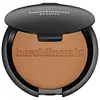What's inside
What's inside
 Key Ingredients
Key Ingredients

 Benefits
Benefits

 Concerns
Concerns

 Ingredients Side-by-side
Ingredients Side-by-side

Mica
Cosmetic ColorantOctyldodecyl Stearoyl Stearate
EmollientSilica
AbrasiveBoron Nitride
AbsorbentLauroyl Lysine
Skin ConditioningMagnesium Myristate
Caprylic/Capric Triglyceride
MaskingBis-Stearyl Dimethicone
EmollientWater
Skin ConditioningErythrulose
TanningPalmitoyl Isoleucine
Skin ProtectingIsochrysis Galbana Extract
Skin ConditioningPolyglyceryl-2 Triisostearate
EmulsifyingPtfe
Polyethylene
AbrasivePhenoxyethanol
PreservativeTitanium Dioxide
Cosmetic ColorantIron Oxides
CI 77163
Cosmetic ColorantMica, Octyldodecyl Stearoyl Stearate, Silica, Boron Nitride, Lauroyl Lysine, Magnesium Myristate, Caprylic/Capric Triglyceride, Bis-Stearyl Dimethicone, Water, Erythrulose, Palmitoyl Isoleucine, Isochrysis Galbana Extract, Polyglyceryl-2 Triisostearate, Ptfe, Polyethylene, Phenoxyethanol, Titanium Dioxide, Iron Oxides, CI 77163
Ethylhexyl Palmitate
EmollientTitanium Dioxide
Cosmetic ColorantCaprylyl Methicone
Skin ConditioningC10-18 Triglycerides
EmollientMethyl Methacrylate Crosspolymer
Mica
Cosmetic ColorantPolysilicone-11
Silica
AbrasiveCera Microcristallina
Emulsion StabilisingSynthetic Wax
AbrasiveCyclopentasiloxane
EmollientAlumina
AbrasivePentaerythrityl Tetrabehenate
EmollientCaprylic/Capric Triglyceride
MaskingTridecyl Trimellitate
EmollientButyloctyl Salicylate
Skin ConditioningLauryl PEG-10 Tris(Trimethylsiloxy)Silylethyl Dimethicone
EmulsifyingParaffin
PerfumingPolymethylsilsesquioxane
Tristearin
Skin ConditioningPhenoxyethanol
PreservativeAluminum Hydroxide
EmollientTriisostearyl Citrate
EmollientMagnesium Myristate
Triethoxycaprylylsilane
Ethylhexylglycerin
Skin ConditioningLaureth-12
EmulsifyingJojoba Esters
EmollientOctyldodecanol
EmollientHelianthus Annuus Seed Wax
Skin ConditioningEchium Plantagineum Seed Oil
Skin ConditioningAcacia Decurrens Flower Wax
EmollientPolyglycerin-3
HumectantHelianthus Annuus Seed Oil Unsaponifiables
EmollientCardiospermum Halicacabum Flower/Leaf/Vine Extract
Skin ConditioningTocopherol
AntioxidantIron Oxides
Ethylhexyl Palmitate, Titanium Dioxide, Caprylyl Methicone, C10-18 Triglycerides, Methyl Methacrylate Crosspolymer, Mica, Polysilicone-11, Silica, Cera Microcristallina, Synthetic Wax, Cyclopentasiloxane, Alumina, Pentaerythrityl Tetrabehenate, Caprylic/Capric Triglyceride, Tridecyl Trimellitate, Butyloctyl Salicylate, Lauryl PEG-10 Tris(Trimethylsiloxy)Silylethyl Dimethicone, Paraffin, Polymethylsilsesquioxane, Tristearin, Phenoxyethanol, Aluminum Hydroxide, Triisostearyl Citrate, Magnesium Myristate, Triethoxycaprylylsilane, Ethylhexylglycerin, Laureth-12, Jojoba Esters, Octyldodecanol, Helianthus Annuus Seed Wax, Echium Plantagineum Seed Oil, Acacia Decurrens Flower Wax, Polyglycerin-3, Helianthus Annuus Seed Oil Unsaponifiables, Cardiospermum Halicacabum Flower/Leaf/Vine Extract, Tocopherol, Iron Oxides
Ingredients Explained
These ingredients are found in both products.
Ingredients higher up in an ingredient list are typically present in a larger amount.
This ingredient is an emollient, solvent, and texture enhancer. It is considered a skin-softener by helping the skin prevent moisture loss.
It helps thicken a product's formula and makes it easier to spread by dissolving clumping compounds.
Caprylic Triglyceride is made by combining glycerin with coconut oil, forming a clear liquid.
While there is an assumption Caprylic Triglyceride can clog pores due to it being derived from coconut oil, there is no research supporting this.
Learn more about Caprylic/Capric TriglycerideWe don't have a description for Magnesium Myristate yet.
Mica is a naturally occurring mineral used to add shimmer and color in cosmetics. It can also help improve the texture of a product or give it an opaque, white/silver color.
Serecite is the name for very fine but ragged grains of mica.
This ingredient is often coated with metal oxides like titanium dioxide. Trace amounts of heavy metals may be found in mica, but these metals are not harmful in our personal products.
Mica has been used since prehistoric times throughout the world. Ancient Egyptian, Indian, Greek, Roman, Aztec, and Chinese civilizations have used mica.
Learn more about MicaPhenoxyethanol is a preservative that has germicide, antimicrobial, and aromatic properties. Studies show that phenoxyethanol can prevent microbial growth. By itself, it has a scent that is similar to that of a rose.
It's often used in formulations along with Caprylyl Glycol to preserve the shelf life of products.
Silica, also known as silicon dioxide, is a naturally occurring mineral. It is used as a fine, spherical, and porous powder in cosmetics.
Though it has exfoliant properties, the function of silica varies depending on the product.
The unique structure of silica enhances the spreadability and adds smoothness, making it a great texture enhancer.
It is also used as an active carrier, emulsifier, and mattifier due to its ability to absorb excess oil.
In some products, tiny microneedles called spicules are made from silica or hydrolyzed sponge. When you rub them in, they lightly polish away dead skin layers and enhance the penetration of active ingredients.
Learn more about SilicaTitanium dioxide is a mineral UV filter widely used in sunscreens and cosmetics.
It is one of only two UV filters officially classified as “mineral” by regulatory agencies, the other being zinc oxide.
Titanium dioxide provides broad-spectrum protection mostly in the UVB and UVAII range, with some protection in the UVAI range.
While its UVA protection isn’t as strong as zinc oxide’s, the difference is minor.
A common myth is that mineral UV filters reflect UV light. However, modern research shows titanium dioxide absorbs UV radiation like chemical filters (~95% absorption & 5% reflection).
Thanks to its non-irritating nature, titanium dioxide is suitable for sensitive, acne-prone, or redness-prone skin. It is unlikely to cause "eye sting" like other sunscreen ingredients.
A major drawback of this ingredient is its white cast and thick texture. This is why mineral sunscreens often leave a white cast and are less cosmetically elegant than chemical/hybrid sunscreens.
To improve white cast and spreadability, micronized or nano-sized titanium dioxide is often used.
There are ongoing concerns surrounding nano-titanium oxide's impact on marine ecosystems.
There is no conclusive evidence that any form of titanium oxide (or any other sunscreen ingredients) will cause harm to marine ecosystems or coral reefs. The science is still developing but many consumers are keeping a close eye on this issue.
Please note, many destinations have reef-safety sunscreen rules. For instance, the U.S. Virgin Islands advises all visitors to use non-nano mineral sunscreens.
Nano mineral sunscreens once raised safety concerns about absorption into skin.
Extensive research has shown that they do not penetrate healthy or damaged skin; they remain safely on the surface and the top layer of dead skin (stratum corneum).
You'll likely find titanium dioxide bundled with alumina, silica, or dimethicone. These ingredients help make titanium dioxide highly photostable; this prevents it from interacting with other formula components under UV light.
Learn more about Titanium DioxideThis ingredient is a combination of red, black, and yellow iron oxide pigments. This combination of colors is usually found in foundation, because it results in a "skin" color.